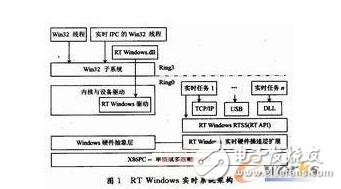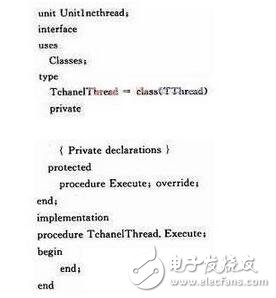Real-time performance is an important performance indicator for CNC systems.
Communication is on the open CNC system development platform composed of IPC (Industrial Personal Computer) and motion controller. Although this master-slave structure ensures that the motion control commands are executed in the motion controller in high speed and in real time, but in the PC. On the platform, many tasks such as real-time display, pre-processing calculations, system status monitoring, etc. still need to be completed. In order to ensure the real-time performance of the system, it is proposed to adopt multi-threading technology to improve the real-time performance of the system through multi-task parallel processing.
1 process and thread and multi-threading technology
The Windows operating system supports both multi-process and multi-threading. A process is an instance of an application. An execution process is a program that is loaded into memory to be executed, including the execution code of the currently executed application and some environment information related to program execution. Each process has the resources of the entire computer, without having to know the information of other processes on the computer. Usually, at least one thread in each process executes the code in its own address space. This thread is called the main thread. If the main thread finishes running, the system will automatically clear the process and other address spaces.
A thread is a path executed internally by a process. It is the basic entity that the operating system allocates CPU time and is the smallest unit in which the program runs. Each process starts with the main thread and executes the application. A thread consists of a stack, the state of a CPU register, and a population in the list of system calls. Each process can contain more than one thread, which can execute code in the process address space independently and share all resources in the process.
The smallest unit of Windows system allocation processor time is threads, and the system keeps switching between threads. In a PC, only one thread is running at a time. Usually, the time slice for each thread is small (ms level), so the real-time performance of the fast system is guaranteed.
To implement multi-threaded programming, you can create a Worker Thread and a User Interface Thread. The auxiliary thread is mainly used to execute the NC program, coordinate display, dynamic simulation and data preprocessing; the user interface thread is used to process the user's input and respond to user generated events and messages.
2 Real-time multitasking implementation
CNC system software has two characteristics of real-time and multi-tasking. There are many tasks to be managed and controlled in the CNC system. For example, when the CNC system is in the process control state, in order to ensure the continuity of the machining, there is no pause between the various blocks, and the preprocessing and interpolation calculation of each NC machining program segment , position control and various auxiliary control tasks must be carried out in time; in order to enable the operator to understand and intervene in the working state of the numerical control system in time, the system should perform some human-computer interaction work in time while executing the processing tasks, that is, display the processing status, Receiving various control signals, etc., which change the state of the system, which are input by the operator through the operation panel. In order to timely check and predict various faults of software and hardware, the system must run the diagnostic program in time while running the control program and the human-computer interaction program; in addition, the system may be required to complete other tasks such as communication in time. It can be seen that the ideal NC program should have the processing capability of real-time multi-tasking.
Aiming at the two characteristics of real-time and multi-tasking of CNC system software, time-sharing parallel processing technology is used to determine the software structure of CNC system. Time-sharing parallel processing technology refers to a processor performing multiple tasks simultaneously. The system processes and completes each task in a time slice rotation manner, that is, assigns a CPU time to each task in a certain rotation order to perform processing of each task. From a micro perspective, each task takes up CPU in a time-sharing manner; from a macro perspective, the CPU completes multiple tasks in parallel for a period of time. In the software design, the multi-threading technology of Windows is used to solve the real-time multi-task problem of the CNC system based on the principle of “share time sharingâ€. The priority preemption mode is applied to perform thread scheduling to meet the real-time requirements of the system, and the parallel processing and the resource sharing method are used to implement parallel processing.
2.1 The overall design of the system thread
Windows provides two threads, a secondary thread and a main thread. The main thread has a window, so it has its own message loop that can process messages, allowing the program to respond quickly to commands and other events; the worker thread has no windows, so it does not need to process the message. It can be used to do some time-consuming work to prevent the processing of program messages from being blocked when the main thread processes the work. In the software design, modules with parallel requirements are placed in separate threads to realize multi-tasking parallel operation of the system. According to the analysis of real-time multitasking of the system, the threads in the software system are designed as:
(1) main thread
The main thread is the first thread created when the application starts, and other threads are created directly or indirectly by the main thread. The main thread is responsible for creating the customer interface, data display, interaction with the client, system initialization, and monitoring of other threads.
(2) Decoding thread
The decoding thread is created by the main thread and is responsible for decoding the program and storing the computational structure in the public data area to provide a data source for the communication thread.
(3) Communication thread
The communication thread is responsible for data transmission between the upper and lower machines. The transmission between the upper and lower machines takes place one after another. The communication thread receives the data transmitted from the lower computer, identifies it according to the protocol defined in advance, and determines whether it is necessary to transmit the interpolation command to the lower computer according to the result of the identification, and also needs to notify the main thread to handle the abnormal situation. .
The task undertaken by the communication thread is a strong real-time periodic task. The task undertaken by the decoding thread is a weak real-time task, and the main thread is responsible for real-time sudden tasks. Therefore, according to the real-time strength of the system task, the corresponding priority can be set for each thread to ensure real-time performance. The main thread has the same priority as the process, the communication thread has a higher priority than the main thread, and the decoding thread has a higher priority than the main thread is lower than the communication thread.
In the thread priority setting, the communication thread has the highest priority, which enables the communication thread to successfully seize the resources of other threads when the CPU time and other resources are needed, so as to ensure smooth communication between the upper and lower machines, so that the lower machine is in processing. The process can be realized smoothly, and the lower computer can notify the host computer in time when an abnormal situation occurs. Since the communication action is performed according to a certain frequency, the communication thread does not always occupy CPU resources, so that other threads cannot be operated because of its high priority.
The specific implementation principle architecture is shown in Figure 1.

2.2 The specific implementation of the system thread
Delphi provides a number of components related to multi-threaded programming, the most important of which is the Tthread class. This article uses it to implement multi-threaded programming. This class encapsulates most of the thread-related methods, and the use of the Tthread class greatly simplifies the development of multithreaded programs. The Tthread class is an abstract class. You can't create an instance of it directly, but you can create its derived class. Create method in the Delphi menu, select "File" → "New" → "Other" → "New", select the "Thread Object" item, enter the name of the new thread class in the dialog box, confirm a new one is created Thread class:

Among them: "private" and "protected" are used to define variables and program functions, "procedure Execute; override;" is a thread function used to write the execution part of the thread. At the same time Delphi also provides a variety of functions to run and terminate threads. After the thread's derived class is created, an object of that class can be generated to represent the execution thread of the application. After each thread is created, the NC's interpreter and communication program are placed in their respective thread functions, and then the thread object is created. Several threads are set to generate several objects, and functions such as opening or terminating threads are written in the object to control the thread. Running.
3 Conclusion
The development of high-end CNC real-time operating system based on Windows platform realizes not only the real-time function can be added to the Windows platform, but also the real-time functions are very scalable. The goal of this project is to implement the design of this real-time system on the Windows XP Embedded platform, so that it has the characteristics of embedded devices required for high-end CNC systems.
Dash Cam Front And Inside,Dash Dual Cam,Dashcam For Cars,Sharper Image Dash Cam
SHENZHEN ROSOTO TECHNOLOGY CO., LTD. , https://www.rdtkdashcam.com